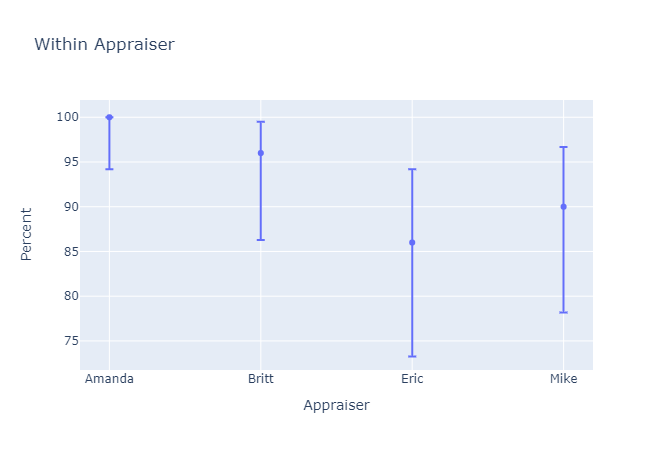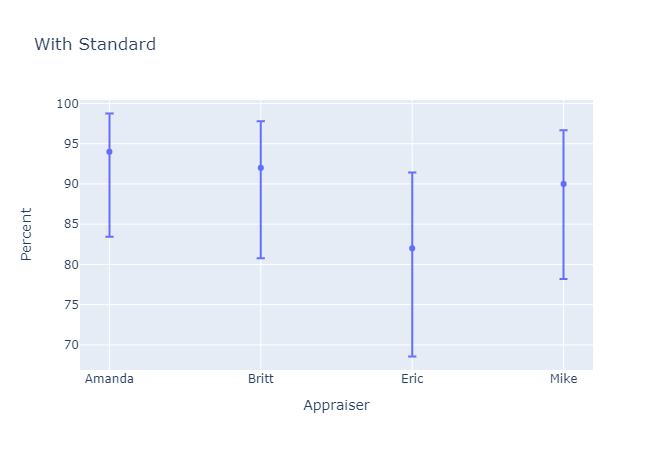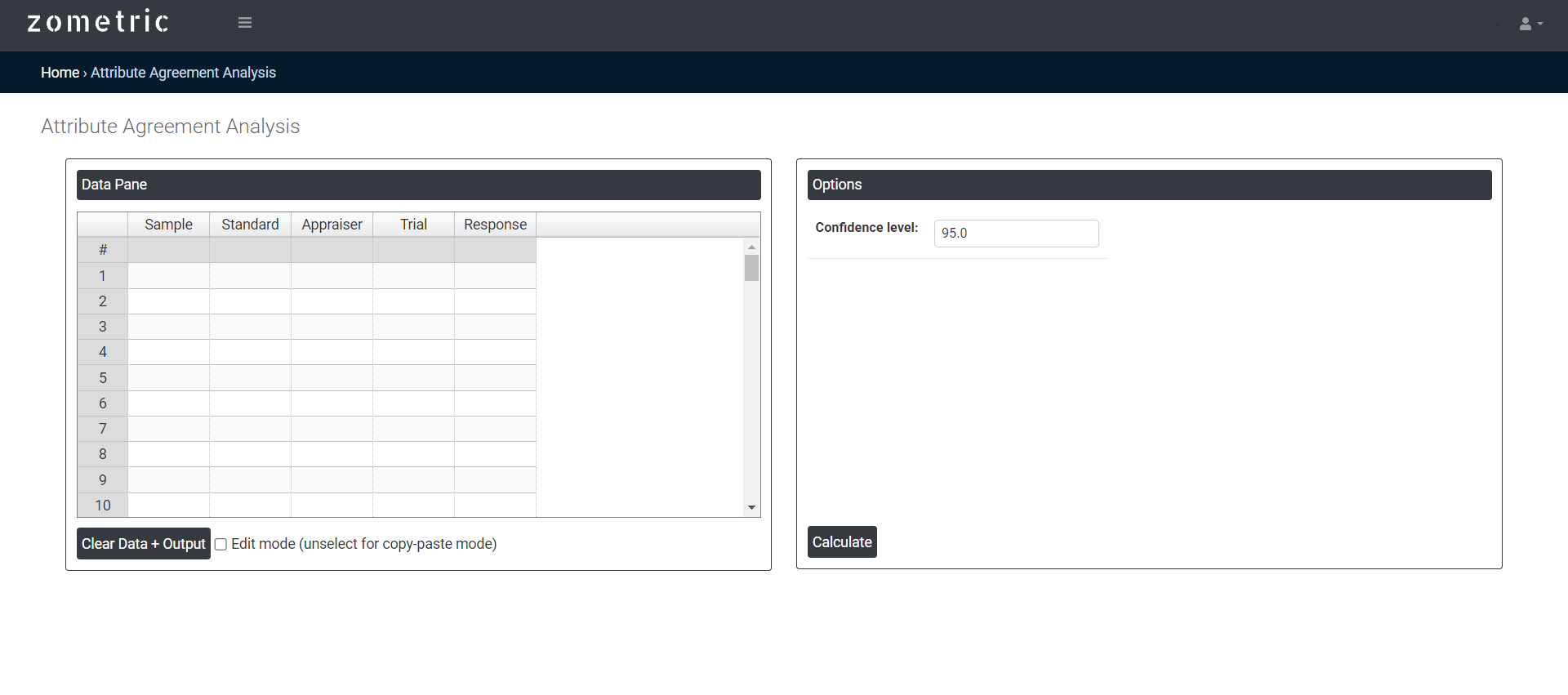Table of Contents
Try Statistical Software for Free
What is attribute agreement analysis?
Attribute agreement analysis (AAA) is a statistical method used to assess the agreement among multiple evaluators or observers in the classification of items into categories based on a set of attributes. It is a technique that is often used in quality control, product development, and market research to evaluate the consistency and reliability of the ratings or evaluations provided by different evaluators.
In an Attribute agreement analysis, a set of items is presented to a group of evaluators, and each evaluator is asked to classify the items based on a set of attributes or characteristics. The classifications are then compared, and statistical measures are used to assess the level of agreement among the evaluators. The analysis can be used to identify sources of variation, such as differences in training, understanding of the attributes, or interpretation of the classification rules.
When to use attribute agreement analysis?
Attribute agreement analysis (AAA) is typically used when an organization wants to evaluate the consistency and reliability of the ratings or evaluations provided by multiple evaluators or observers. AAA is a useful technique in situations where classification or rating of items is based on a set of attributes or characteristics. Here are some specific situations where AAA can be used:
- Quality control: AAA is commonly used in quality control to ensure that products meet the specified quality standards. Evaluators can be asked to classify defects or quality issues based on a set of attributes or characteristics, and the agreement among the evaluators can be analyzed to determine if there are any inconsistencies or variations in the classifications.
- Market research: AAA can be used in market research to evaluate the consistency of ratings or evaluations of products or services. Evaluators can be asked to rate the products or services based on a set of attributes or characteristics, and the agreement among the evaluators can be analyzed to determine if there are any differences in perceptions or understanding of the attributes.
- Product development: AAA can be used in product development to evaluate the consistency of ratings or evaluations of prototypes or designs. Evaluators can be asked to classify the prototypes or designs based on a set of attributes or characteristics, and the agreement among the evaluators can be analyzed to determine if there are any inconsistencies or variations in the classifications.
Overall, AAA is useful when an organization wants to evaluate the consistency and reliability of evaluations or ratings provided by multiple evaluators or observers. It is particularly useful when classification or rating of items is based on a set of attributes or characteristics.
Guidelines for correct usage of attribute agreement analysis
- Evaluate samples randomly within a replicate
- Use a known reference rating for each sample
- Have at least 50 samples for an adequate study
- Rate each sample at least twice in random order
- Have at least 3 appraisers for an adequate study
- Select representative appraisers randomly
- Appraisers should rate approximately the same number of samples from each category
- For binary response, use samples that are marginally acceptable and unacceptable
- Attribute agreement analysis must be balanced
Alternatives: When not to use attribute agreement analysis
- When dealing with binary attribute measurement gage that produces pass/fail data, utilize the Attribute Gage Study (Analytic Method) for analysis.
- In the case of continuous data, opt for a gage R&R study
Example of attribute agreement analysis?
A textile printing company has appraisers who rate the print quality of cotton fabric on a 1 to 5 point scale. The quality engineer aims to evaluate the accuracy and consistency of the ratings provided by the appraisers. To achieve this, the engineer requests four appraisers to rate the print quality of 50 fabric samples twice in random order. As the data contains a standard reference value for each sample, the quality engineer can compare the consistency and accuracy of the appraisers' ratings with the reference value, as well as with each other. She has performed this in following steps:
- She worked all day and gathered the necessary data.
- Now, she analyzes the data with the help of https://qtools.zometric.com/
- Inside the tool, she feeds the data. Also, she puts 95 as the confidence level.
- After using the above mentioned tool, she fetches the output as follows:


How to do attribute agreement analysis
The guide is as follows:
- Login in to QTools account with the help of https://qtools.zometric.com/
- On the home page, you can see attribute agreement under Measurement System Analysis.
- Click on attribute agreement and reach the dashboard.
- Next, update the data manually or can completely copy (Ctrl+C) the data from excel sheet and paste (Ctrl+V) it here.
- Next, you need to put the value of confidence level.
- Finally, click on calculate at the bottom of the page and you will get desired results.
On the dashboard of attribute agreement, the window is separated into two parts.

On the left part, Data Pane is present. In the Data Pane, each row makes one subgroup. Data can be fed manually or the one can completely copy (Ctrl+C) the data from excel sheet and paste (Ctrl+V) it here.
On the right part, there are many options present as follows:
- Confidence level: In attribute agreement analysis, the confidence level is a statistical measure that reflects the level of confidence that can be placed in the results of the analysis. It represents the probability that the true level of agreement between the appraisers is within the specified range. The confidence level is often expressed as a percentage, and a higher confidence level indicates greater certainty in the results. For example, a confidence level of 95% means that there is a 95% probability that the true level of agreement falls within the specified range. The confidence level is an important consideration in interpreting the results of attribute agreement analysis, as it indicates the level of certainty that can be placed in the conclusions drawn from the analysis.